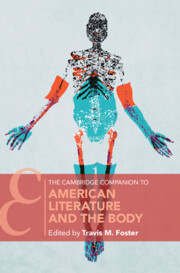Book contents
- The Cambridge Companion to American Literature and the Body
- The Cambridge Companion to American Literature and the Body
- Copyright page
- Contents
- Contributors
- Chronology of Publications and Events
- Acknowledgments
- Introduction
- Part I Genres
- 1 Bodies in Early US-Atlantic Theater
- 2 Sentimentalism and the Feeling Body
- 3 Slavery, Disability, and the Black Body/White Body Complex in the American Slave Narrative
- 4 Monstrous Bodies of the American Gothic
- 5 Bodies at War
- 6 Decolonizing the Body in Multiethnic American Fiction
- 7 Science Fiction’s Humanoid Bodies of the Future
- 8 Contemporary North American Transgender Literature
- Part II Critical Methodologies
- Further Reading
- Index
- Cambridge Companions To …
5 - Bodies at War
from Part I - Genres
Published online by Cambridge University Press: 30 July 2022
- The Cambridge Companion to American Literature and the Body
- The Cambridge Companion to American Literature and the Body
- Copyright page
- Contents
- Contributors
- Chronology of Publications and Events
- Acknowledgments
- Introduction
- Part I Genres
- 1 Bodies in Early US-Atlantic Theater
- 2 Sentimentalism and the Feeling Body
- 3 Slavery, Disability, and the Black Body/White Body Complex in the American Slave Narrative
- 4 Monstrous Bodies of the American Gothic
- 5 Bodies at War
- 6 Decolonizing the Body in Multiethnic American Fiction
- 7 Science Fiction’s Humanoid Bodies of the Future
- 8 Contemporary North American Transgender Literature
- Part II Critical Methodologies
- Further Reading
- Index
- Cambridge Companions To …
Summary
At first glance, this scene has nothing to do with war. Even though much of the book takes place during the Civil War, there are no references to the things we would expect from war literature – no soldiers, combat, weapons, or wounds. The tone is sentimental and religious, not realist and secular or even profane. The scene focuses on women and gentleness, highlighted by such alliterations as the “spring sunshine streamed” and “face … full” of “painless peace.” The passage does not portray men’s strength or masculinized heroism. And yet I want to start here, to suggest that this scene is not only a Civil War scene, but one that illuminates a key means by which American literature grapples with representations of the body at war: It focuses on white women’s suffering as an affirmation of national innocence.
- Type
- Chapter
- Information
- Publisher: Cambridge University PressPrint publication year: 2022

